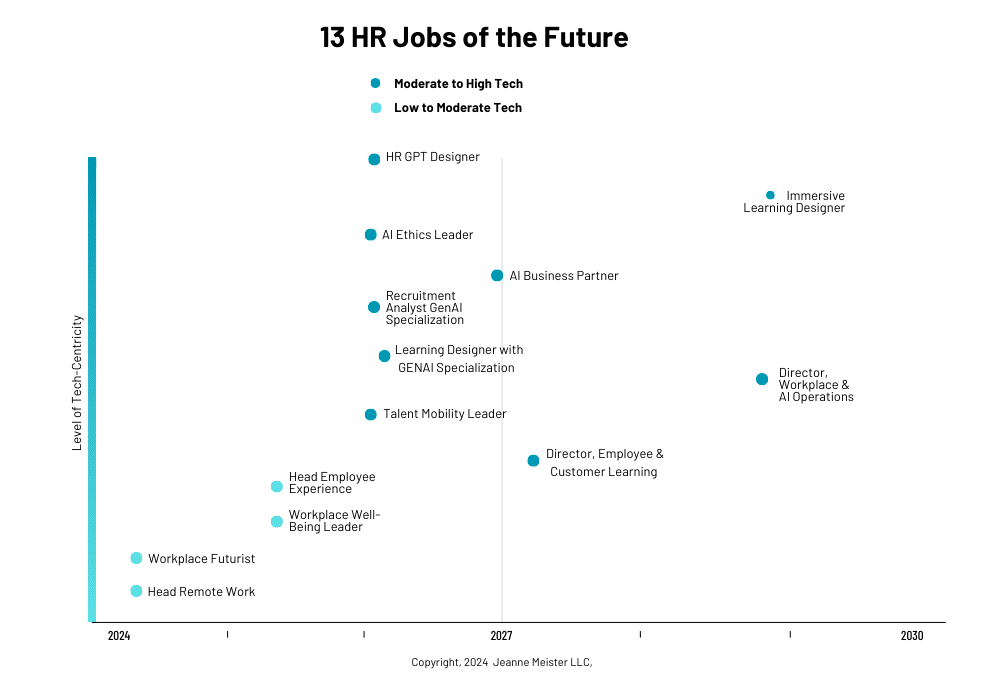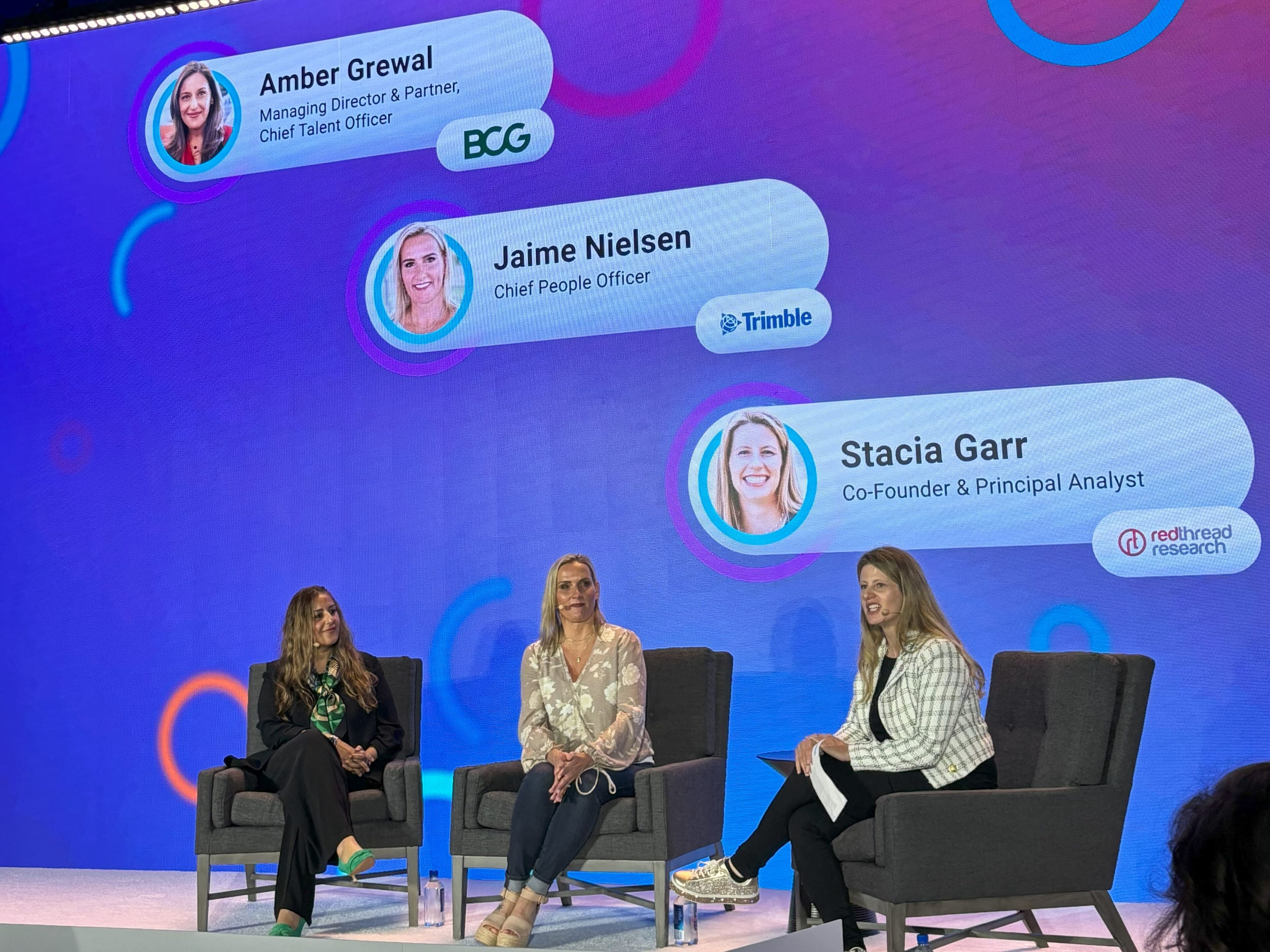Humans and AI co-pilots working side by side, an increased focus on building gen AI literacy and a permanent expectation for workplace flexibility are coming together to form what author Thomas Friedman calls our collective “Promethean moment.”
As Friedman says, “Promethean moments are not driven by a single invention, like a printing press, but rather by a technology super-cycle. It’s a moment in time when major disruptions occur all at once and change how we digitize, process, learn, communicate, share and act, with the help of AI.”
In HR, this is our Promethean moment as we navigate a complex future, one with limitless possibilities in how we work, where we work, who we work with and what we expect in our workplace.
After speaking with dozens of HR leaders, I have identified 13 HR jobs of the future (a combination of new jobs and new workstreams). Each job is arranged on a 2×2 grid; the x-axis depicts time—from now until 2030—and the y-axis depicts “technology centricity” (i.e., the extent to which these jobs require low to moderate or moderate to high levels of technology and gen AI literacy.)
While some of these HR roles are new positions, others are new workstreams, as the HR role expands integrating gen AI. For example, the role of HR GPT Designer (i.e., designing custom HR GPT applications) is to understand and interpret complex problems in areas ranging from people analytics, learning and development, and talent acquisition, and assume gen AI literacy, a working knowledge of prompting, responsible AI and change management.
These 13 HR jobs of the future embody five core workplace themes enabling leaders to embrace reinvention as a strategy where humans and machines collaborate to deliver in which to the organization.
1. Building gen AI literacy
LinkedIn’s 2024 Workplace Learning Report finds four out of five workers say they want to learn more about AI and how it can be used in their role, but just 38% of U.S. executives say they’re currently helping workers build AI literacy.
PwC is addressing this disconnect with a focus on building gen AI literacy.
Bret Greenstein, PwC partner, and generative AI leader at PwC, shares, “PwC is making a commitment of $1 billion to build a transformational capability using gen AI across the firm and client engagements. Our goal: Innovate fast and learn fast so we have the best skills to help our clients on their AI journey. This commitment goes well beyond training our workforce on prompt engineering to enable gen AI in our business processes and workflows. We are also upskilling our leaders in a weeklong gen AI immersion program to help them understand the use cases, ethics, benefits and change-management issues of using gen AI. Working with our clients, we are seeing huge opportunities to leverage gen AI from enhancing productivity and workflow design in handling back-office finance and supply chain to improving HR, customer sales and service.”
In the HR function, we will see more organizations embed gen AI literacy into key HR roles such as Recruitment Analyst with gen AI specialization and Learning Designer with gen AI specialization to enable personalization and productivity at scale.
2. Working from anywhere
Increasingly, work is not somewhere you go, it’s something you do, wherever you are. To ensure distributed workers are successful, Doist has created a new role, Head of Remote Work. This role is responsible for creating exceptional remote employee experiences. At Doist, a 100% remote company, Chase Warrington, the Head of Remote Work, shares how a growing part of his job is to “add the human touch to remote work by executing intentional experiences where Doist employees come together once a quarter to network, collaborate and ideate on the future. Curating these experiences is as important as codifying how to be successful as a remote worker.”
As more candidates seek out jobs offering flexibility, companies need to create in-person experiences where “the off-site becomes the new on-site.” This—coupled with accessing a tech stack of online tools to obtain virtual credit cards, access just-in time career development and engage in visual online collaboration—will be some of the critical success factors to work remotely.
3. Building human-machine partnerships
Gen AI is your new work buddy, and this is transforming how employees work and how managers lead. Besides learning how to use AI responsibly, managers need to understand how gen AI will augment, replace and alter many roles. This realization is behind one of the key findings of Mercer research where 58% of business leaders believe technology is already advancing faster than they can retrain workers, and only 28% of HR leaders are confident they can make human and machine teaming a success.
One company that has been using AI in talent acquisition since 2018 is DBS Bank. James Loo, Managing Director, Group Head, HR Shared Services & HR Systems, DBS Bank, shares how DBS was an early adopter in using AI to recruit relationship bank managers. “We created our first recruitment bot in 2018 and today, we have realized increases in both the speed to hire and the accuracy of hiring relationship managers. Not only does this save time for hiring managers by being able to accurately identify candidates with the right skills and experience, but it also improves the hiring rate for the bank. DBS recruiters can then focus on better understanding our labor market and the changing skills needed for new jobs.”
As an early adopter to integrating AI into HR, DBS requires recruiters to train their recruitment bot to handle routine tasks of screening candidates and answering frequently asked questions. In the future, gen AI literacy will be integrated into many HR roles, and this is especially important for the Human Resource Business Partner (HRBP). Loo believes “Some roles like HR Business Partner will evolve to be AI Business Partner, coaching business leaders on upskilling and reskilling of employees whose roles will be transformed by gen AI.” Other new roles will be created such as AI Ethics Leader to ensure human-machine partnerships are acting responsibly.
Learn more about how AI will impact HR jobs of the future at the free HR Technology Online, June 12-13. Register here.
4. Driving innovation and wellbeing in the workplace
As business leaders envision new ways to innovate during rapid change, a new role is emerging at the intersection of HR, real estate, technology and communications. The role is Workplace Futurist and is responsible for setting the organization’s strategy for the future of work, as well as proposing reskilling and upskilling efforts for current employees as well as new ways to attract future employees. The position synthesizes big-picture inputs from academia and industry associations, and examines competitive threats in the marketplace to envision new jobs and skills critical to the organization’s continued success.
This focus on the future of work is leading companies to acknowledge the need to address employee wellbeing as a business strategy—and not just an office perk. We are already seeing some companies such as Cisco, Deloitte and PwC create new roles for Workplace Wellbeing Leaders. I expect to see more as American Psychological Association research found 77% of U.S. workers reported stress at work in the past month, with 57% reporting negative health effects as a result. Workplace Wellbeing Leaders provide strategic management for seven pillars of holistic employee wellbeing, including physical, career, emotional, community, social, financial and purpose, and see this as a business imperative.
5. Creating a personalized employee experience
Designing an employee experience that mirrors your company’s best customer experience is what makes a great employee experience. Now, gen AI can scale and personalize this.
Sander de Bruijn is Head of Global Employee Experience at ING, a job he has held since 2018, and leads a team of seven experts in employee experience. One of the key components of the early employee experience program was to improve the employee onboarding process. Says Sander de Bruijn, “Our early goal was to personalize the onboarding process, from accepting a job to starting a job. We do this by nudging new hires with engaging content about their new job and using AI to provide managers with personalized communications to welcome new hires.”
The vision of employee experience at ING is to be as personal, easy and instant as possible while automating manual work. Recently, ING removed all approval steps in the time and absence process. Now when someone requests a day off, they get an instant automated approval, and managers track this in a dashboard. This reduces manager approvals by 8,000 per month and is a much faster process for employees.
The goal is to make employees’ lives at work better, and, as Sander de Bruijn says, “Every time we do this, we enable ING teams to better serve ING customers.”
The 13 HR jobs of the future underscore the growing importance of gen AI and the realization this is not a zero-sum game. Some roles in HR will be new, like HR GPT Designer or Head of Remote Work; others will leverage gen AI to automate manual work; and most jobs will evolve to include new ways to activate gen AI into current HR roles. As gen AI expands across the enterprise, this will improve the efficiency and effectiveness of HR but also provide middle managers with superpowers to quickly access employee sentiment, personalize communications and anticipate flight risks. The calls to reinvent HR can now be met by integrating gen AI into HR.
Credit: Source link










